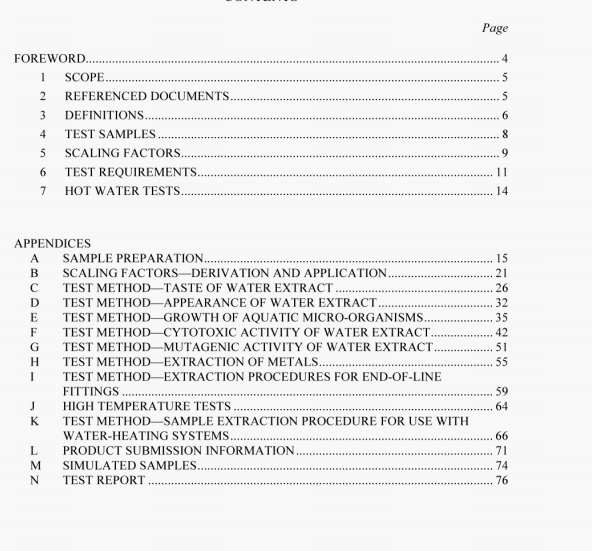AS/NZS 4020:2005 pdf – Testing of products for use in contact with drinking water.
Where the surface area-to-volume ratio adopted for testing is greater than the end-use ratio, a scaling factor may be applied (see Clause 5). Successful evaluation of the product having the highest surface area-to-volume ratio shall qualify all lower surface area-to-volume ratios in the product range. For example. for polyvinyl chloride pipe manufactured to AS/N/S 1477. the smallest PN 12 pipe is DN 20 haing an internal surface area of 169 000 mm’ per litre of contents. Successful ealuation of UN 20 pipe shall qualify all of the PN 12 or lower-pressure class pipes manufactured to AS/N/S 1477.
Where a manufacturer does not produce a complete range of product sizes, testing of the highest surface area-to-volume ratio product will apply to the remainder of the range having lower surface area-to-v 0 lume ratios.
Where the material being tested is not in final product form, a statement to that affect shall be included in the test report.
NOTES:
I A format for presenting data to the testing laborator> is gisen in Appendix L.
2 Care should be taken in considering the approal of materials that are not in final product form. The performance of materials is affected by the processing conditions, which may influence results of the tests described in this Standard.
An option that may be considered in some circumstances is the use of simulated samples. but the decision to use this approach is made in the relevant product Standard.
NOTE: A description of the use of simulated samples, if allowed. is given in Appendix M.
A4 PROIW(’T EXPOSURE
A4.I In-the-product exposure
In-the-product exposure shall be used, wherever possible, for the extraction tests. Samples are completely tilled with extractant water so that the surface area-to—volume ratio is equal to the actual ratio in end use.
In certain cases, the product in end use will effectively be in contact with a larger volume of waler than in the test. In such cases, a scaling factor (see Clause 5) may be applied in the evaluation of the test result.
The extractant water volume will vary according to the size of the product: therefore it is necessary to ensure that a sufficient volume of extractant (typically about 250 ml) can be obtained [or each test. For products having a small volume, it may he necessary to use more than one sample for each test to obtain the required volume of extractant water.
Because of the need for a tightly sealed test container, in-the-product exposure cannot be applied to the growth of micro-organisms test specified in Appendix E. The growth of micro-organisms test shall be carried out by immersion exposure (see Paragraph A4.2). Products may need to be sectioned to obtain the required sample size for this immersion exposure.
A4.2 Immersion exposure
Immersion exposure shall he used for samples that cannot be evaluated by in-the-product exposure. In using immersion exposure. steps shall be taken to prevent contact between the extractant and product surfaces that, under end-use conditions do not come in contact with drinking water. The sample is immersed in extractant water contained in a clear borosilicate glass test container (A2.3).
During the extraction, samples shall always be completely submerged in the extractant water. If the density of the sample is less than that of water, the sample is kept submerged by using glass-encapsulated weights.
AS/NZS 4020:2005 pdf – Testing of products for use in contact with drinking water
